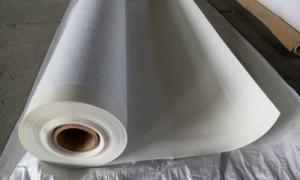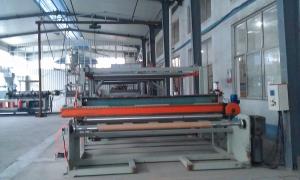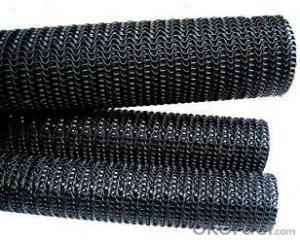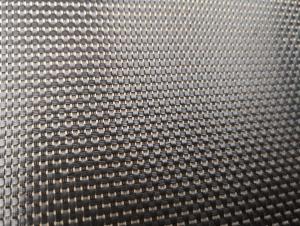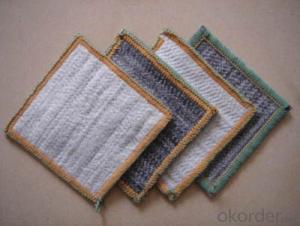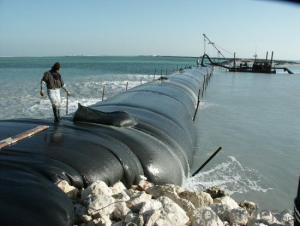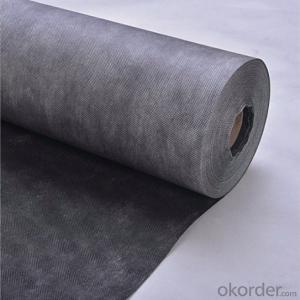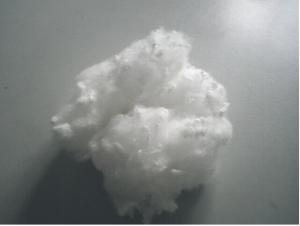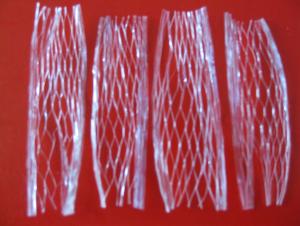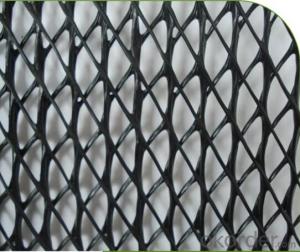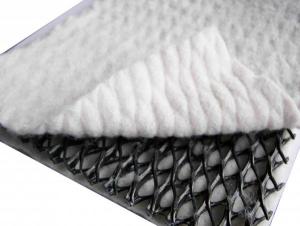PVC Waterproof Membrane/PVC Membrane/PVC Roof Membrane
- Loading Port:
- Qingdao
- Payment Terms:
- TT or LC
- Min Order Qty:
- 1000 m²
- Supply Capability:
- 500000 m²/month
OKorder Service Pledge
OKorder Financial Service
You Might Also Like
PVC Waterproof Membrane Introduction
Polyvinyl Chloride (PVC) waterproof membrane is a new polymer waterproof membrane which is made from polyvinyl chloride resin, and mixed with plasticizer, filler, antioxygen, ultraviolet absorber and other auxiliaries.
PVC Waterproof Membrane Specification
Length | 20m/roll or customized |
Width | 2.05m |
Thickness | 1.2mm; 1.5mm; 2.0mm |
If exposed | Exposed, Non-exposed |
Type | Homogeneous, Reinforced with fabric backing |
Color | White/Grey or customized |
PVC Waterproof Membrane Technical Data Sheet
PVC Waterproof Membrane | Standard: GB12952-2011 | ||||||
NO. | Item | Unit | Value | ||||
H | L | P | |||||
1 | Resin Thickness on Middle Mesh ≥ | mm | - | - | 0.4 | ||
2 | Tensile Properties | Max. Strength ≥ | N/cm | - | 120 | 250 | |
Tensile Strength ≥ | Mpa | 10.0 | - | - | |||
Elongation at Max. Strength ≥ | % | - | - | 15 | |||
Breaking Elongation ≥ | % | 200 | 150 | - | |||
3 | Dimensional Stability after Heat Treatment ≤ | % | 2.0 | 1.0 | 0.5 | ||
4 | Foldability at Low Temperature | -25℃ No cracks | |||||
5 | Watertightness | 0.3Mpa, 2h No penetration | |||||
6 | Resistance to Impact | 0.5kg*m, No penetration | |||||
7 | Resistance to Static Loading* | - | - | 20kgs No penetration | |||
8 | Joint Peel Strength≥ | N/mm | 4.0 or membrane broken | 3.0 | |||
9 | Right Angle Tearing Strength≥ | N/mm | 50 | - | - | ||
10 | Trapezoid Tearing Strength≥ | N | - | 150 | 250 | ||
11 | Water Absorption (70℃, 168h) | After immersing≤ | % | 4.0 | |||
After drying≥ | % | -0.40 | |||||
12 | Aging in Hot Weather (80℃) | Time | 672h | ||||
Appearance | No bubbles, cracks, layering, sticky,holes | ||||||
Max. Tensile Retention Rate ≥ | % | - | 85 | 85 | |||
Tensile Strength Retention Rate ≥ | % | 85 | - | - | |||
Elongation Retention Rate at Max. Tensile ≥ | % | - | - | 80 | |||
Breaking elongation Retention rate≥ | % | 80 | 80 | - | |||
Low Temperature Flexibility | -20℃ No cracks | ||||||
13 | Chemical resistance
| Appearance | No bubbles, cracks, layering, sticky, holes | ||||
Max. Tensile Retention Rate ≥ | % | - | 85 | 85 | |||
Tensile Strength Retention Rate ≥ | % | 85 | - | - | |||
Elongation Retention Rate at Max. Tensile ≥ | % | - | - | 80 | |||
Breaking elongation Retention rate | % | 80 | 80 | - | |||
Low Temperature Flexibility | -20℃ No cracks | ||||||
14 | Artificial aging* | Time | 1500h* | ||||
Appearance | No bubbles, cracks, layering, sticky, holes | ||||||
Max. Tensile Retention Rate ≥ | % | - | 85 | 85 | |||
Tensile Strength Retention Rate ≥ | % | 85 | - | - | |||
Elongation Retention Rate at Max. Tensile ≥ | % | - | - | 80 | |||
Breaking elongation Retention rate | % | 80 | 80 | - | |||
Low Temperature Flexibility | -20℃ No cracks | ||||||
Remarks: *Resistance to static load is for PVC membranes used on roofing *The time of artificial aging of single-ply roofing membrane is 2500h. *Non-exposed membrane does not require determination of artificial aging. | |||||||
PVC Waterproof Membrane Property
1) Excellent aging resistance.
2) Root resistant penetration, specially used on planting roof.
3) Welding installation. Joints are solid and environment friendly, no pollution.
4) High tensile strength, good elongation and dimensional stability.
5) Good plasticity, easy and suitable for details installation.
6) Fireproof. Fire extinguished out of the ignition resource.
7) Surface is smooth, no fading and dirty resistant.
PVC Waterproof Membrane Application
--All kinds of roofs, such as steel structure roof, planted roof etc.
--Underground engineering, such as building basement, subways, tunnels, air raid shelter, etc.
--Other projects like artificial lake, dam, water reservoir, grain storehouse, etc.



- Q:Help students learn sister, civil engineering materials
- Mortar, steel, masonry, wood, synthetic polymer, waterproof material, decorative materials
- Q:Can earthwork products be used for underground utility installation?
- Yes, earthwork products can be used for underground utility installation. These products, such as pipes, conduits, and manholes, are specifically designed and constructed to be used in the underground utility infrastructure. They provide a reliable and efficient solution for installing various utilities such as water, gas, sewer, and electrical systems beneath the ground.
- Q:What are the different types of concrete barriers?
- There are several types of concrete barriers commonly used, including Jersey barriers, F-shape barriers, K-rail barriers, and New Jersey barriers.
- Q:How do earthwork products contribute to groundwater recharge?
- Earthwork products, such as rain gardens, bioswales, and retention ponds, contribute to groundwater recharge by capturing and filtering stormwater runoff. These products are designed to slow down and absorb rainwater, allowing it to infiltrate into the ground instead of running off into nearby water bodies. This process helps replenish underground aquifers and maintain water levels, ultimately supporting groundwater recharge.
- Q:Can geosynthetic reinforcement be used for soil stabilization?
- Yes, geosynthetic reinforcement can be used for soil stabilization. Geosynthetics, such as geotextiles or geogrids, are commonly employed to improve the mechanical properties of soil, increase its load-bearing capacity, and prevent soil erosion. These materials are often installed in the soil as layers or grids to enhance its stability, reduce settlement, and enhance overall performance in various construction and civil engineering applications.
- Q:What are the different types of geosynthetic tubes used in earthwork?
- There are several types of geosynthetic tubes commonly used in earthwork, including geotextile tubes, geocomposite tubes, and geogrid tubes. Geotextile tubes are made of woven or non-woven fabric and are primarily used for erosion control and sediment dewatering. Geocomposite tubes combine a geotextile fabric with a geonet or geogrid, providing additional strength and filtration capabilities. Geogrid tubes, on the other hand, are composed of high-strength geogrids and are mainly used for soil stabilization and reinforcement. These different types of geosynthetic tubes offer various benefits and applications in the field of earthwork.
- Q:Are earthwork products suitable for slope stabilization?
- Yes, earthwork products are suitable for slope stabilization.
- Q:How do geocells help in load support for parking lots?
- Geocells help in load support for parking lots by confining and stabilizing the base material, such as gravel or soil, preventing it from shifting or settling under the weight of vehicles. This enhances the load-bearing capacity of the parking lot, reduces the risk of rutting and potholes, and increases the overall longevity and durability of the pavement.
- Q:Can earthwork products be used in road embankment construction?
- Yes, earthwork products can be used in road embankment construction. Earthwork products such as soil, gravel, and other materials are commonly used to build road embankments. These materials are compacted and shaped to create a stable and durable base for the road.
- Q:How do geosynthetic liners prevent seepage in irrigation canals?
- Geosynthetic liners prevent seepage in irrigation canals by providing a barrier that restricts the flow of water through the canal walls. These liners are made of synthetic materials, such as geomembranes or geotextiles, which have low permeability and high tensile strength. By installing these liners along the canal walls, they effectively prevent water from seeping into the surrounding soil, minimizing water loss and ensuring efficient irrigation.
1. Manufacturer Overview |
|
|---|---|
| Location | |
| Year Established | |
| Annual Output Value | |
| Main Markets | |
| Company Certifications | |
2. Manufacturer Certificates |
|
|---|---|
| a) Certification Name | |
| Range | |
| Reference | |
| Validity Period | |
3. Manufacturer Capability |
|
|---|---|
| a)Trade Capacity | |
| Nearest Port | |
| Export Percentage | |
| No.of Employees in Trade Department | |
| Language Spoken: | |
| b)Factory Information | |
| Factory Size: | |
| No. of Production Lines | |
| Contract Manufacturing | |
| Product Price Range | |
Send your message to us
PVC Waterproof Membrane/PVC Membrane/PVC Roof Membrane
- Loading Port:
- Qingdao
- Payment Terms:
- TT or LC
- Min Order Qty:
- 1000 m²
- Supply Capability:
- 500000 m²/month
OKorder Service Pledge
OKorder Financial Service
Similar products
New products
Hot products
Hot Searches
Related keywords
